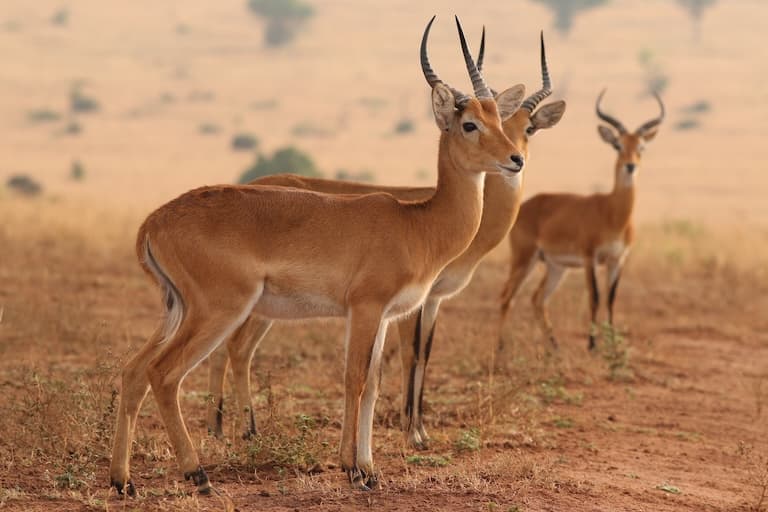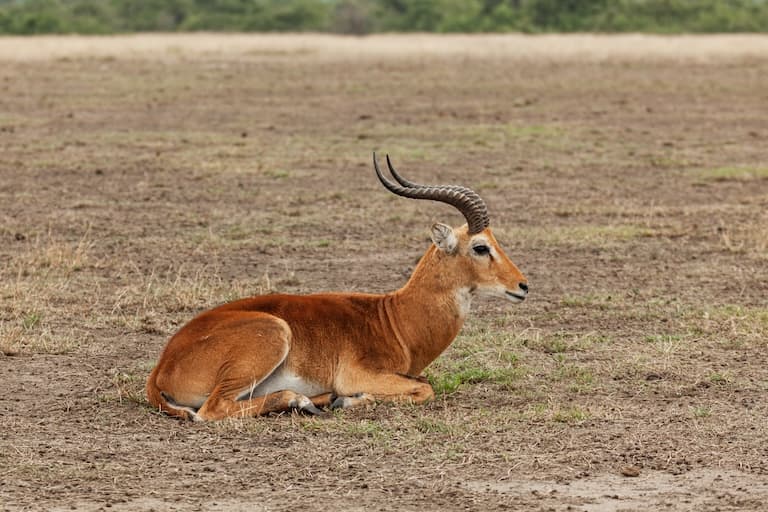Ugandan Kob Profile
As humans and omnivores, we are lucky enough to choose the level of suffering involved in our dinner. Lions certainly can’t be so picky. And sadly, in Uganda, one of the lion’s favourite foods is also one of the most innocent.
There are various subspecies of innocent Kob, including the White-eared, Western, and Corn on the, but today we’re covering the other one: The Ugandan Kob.

Ugandan Kob Facts Overview
| Habitat: | Moist savanna, near water |
| Location: | South Sudan, DRC, Uganda |
| Lifespan: | 17 years |
| Size: | Around a metre (3.4 feet) tall at the shoulder |
| Weight: | Up to 120 kg (265 lb) |
| Colour: | Reddish brown, lighter belly, black stripes on forelegs |
| Diet: | Grasses and reeds |
| Predators: | Lions, other large carnivores |
| Top Speed: | Probably around 60 km/h in bursts, but untested |
| No. of Species: | 1 |
| Conservation Status: | Least Concern |
Kobs are one of the most chilled out – you might go as far as to say boring – antelope species, being low-energy, basic bovids that are fun to look at but don’t really do anything other than eat grass, drink water, and get torn to shreds by lions. They are Africa’s ultimate NPC. They are the disposable racial minority in every pre-1990s horror movie. They are simple animals with simple needs, and in a just world, they would be left alone! But it isn’t the lion to blame for their destruction; their penchant for avoiding predation in the short grass exposes them to the long-range attacks of people with guns.
Interesting Ugandan Kob Facts
1. They’re subspecies
Kob are antelope, which are essentially the ecological equivalent of deer, but from a different family of ungulates.
Antelopes, therefore, look a lot like deer in many respects but are from the Bovidae family, like most of our mammalian livestock today. Goats, sheep, and cows share this family, as do wildebeest, buffalo, and almost all of the 100 or so large quadrupedal herbivore species in Africa.
So, with the exception of a couple of rhinos, a couple of elephants and a sprinkling of stripey punk donkey species, it’s antelopes all the way down.
Within this clade, it can be very difficult to tell one species from another, and sometimes it takes a close inspection of the buttocks (and other times this is just a welcome excuse) to figure it out.
Kobs are impala-shaped members of the Kobus genus, but they’re not the only ones! The Lechwes, the waterbuck and the Puku are in there too, and Kobs make up just one species.
The Ugandan kob is even more specific, being a genetically distinct population of the Kob species. But the name is a bit misleading, because…

2. They’re not Ugandan
Well, maybe a bit. But they’re not exclusively Ugandan. Very few bovids around today acknowledge the colonial lines drawn up when Africa was divvied out between the Western powers, and so, the kob as a species spans from West to East, along the equatorial savanna from the Ivory Coast to South Sudan. Ugandan cobs are the subspecies found in the Easternmost part of this range, from the DRC, through Uganda and into South Sudan.
It used to be found all the way to the Eastern coast, too, but as we’ll touch on later, they’re gone from those countries now.
3. They’re plains animals
This species, including the Uganda subspecies, prefers open grasslands near water. This isn’t an animal that specialises in anything extreme, and only asks to lead a very simple life with grass to eat and water to drink.
Unfortunately, its major predator, the lion, refuses to respect this humble request, and so the Uganda kob really only occupies areas of short grass, where lions find it harder to hide.
And unfortunately again, this avoiding of the lions leaves them wide open for human hunters, legal and otherwise, neither of which cares all that much for their sustainability.

4. They’re generally pretty chill
There are few animals more deserving of being left alone than the kobs. All they want to do is hang out by the water and eat grass. They don’t kill things, they don’t spread mean rumours, and they don’t even really fight hard for mates.
Males strive a bit to claim their territories, but disputes are settled with ritual combat, rather than bloodshed. If the populations are too dense for every male to have a territory, the dominant males will take territories, and the rejects will form a sort of goth subculture, sitting on the steps behind C&A and grumbling against the government.
These clusters of unhoused males are called leks, and are common among antelope, but they’re not as hopeless as they might seem. Most females prefer a lek as they’re a guarantee of mating success, while only a minority will prefer a single male with resources. So, the goths still get plenty of action; they just have to share it with the group.
So, kobs as a whole are pretty chill, but of all the subspecies, the Ugandan kob is likely the most keen to fight1.

5. They kill one another
This certainly puts a question mark in the margin next to the previous fact, agreed. But both can be true! While this species as a whole, and the Ugandan subspecies too, are not prone to fighting, sometimes, just as with human people, kobs can just be jerks.
And like adolescent Londoners, Uganda kobs carry sharp objects around for this very purpose. Lekking males experience the greatest competition, and so this is where the majority of the rare cases of fighting break out.
Fights are pretty standard for horned antelope: clash horns, entangle, and push. While this is primarily a test of strength, serious wounds are sometimes inflicted, too, and in extreme cases, death. These squabbles make dominance in the lek short-lived – even as little as a day or two – while territorial males can hold their turf for years2.
6. Poaching is causing them trouble
We like to think of poachers in pith helmets wearing Imperial moustaches, chasing Robin Williams around the jungle, but while this does happen (with some artistic licence allowed here), the vast majority of poaching is not some glory-hunting rhino murderer but a very poor person with a very poor family hunting their only meal of the day in what happens to be a protected area.
And this has been the story of the Ugandan kob, and thousands of similar species across Africa and the rest of the world.
In fact, as limited as it is in its current range, it once spanned Tanzania and Kenya too, but has been hunted to extinction in these countries. And of what’s left of the Uganda kob, 98% or more are found in protected areas, having been wiped out from everywhere else.
Luckily for the Uganda kob, though, this creature isn’t valuable enough to trophy hunters to take the risk of poaching them all that much, and their numbers are still plentiful enough to be of least concern, even in the face of local hunting pressure. Though they are in decline3.
Uganda Kob Fact-File Summary
Scientific Classification
| Kingdom: | Animalia |
| Phylum: | Chordata |
| Class: | Mammalia |
| Order: | Artiodactyla |
| Family: | Bovidae |
| Genus: | Kobus |
| Species Name: | kob |
Fact Sources & References
- Richard (1991), “The behavior guide to African mammals”, Internet Archive.
- Buechner & Schloeth (1965), “Ceremonial Mating Behavior in Uganda Kob”, Wiley Online Library.
- (2016), “Kobus kob ssp. thomasi”, The IUCN Red List of Threatened Species 2016.
